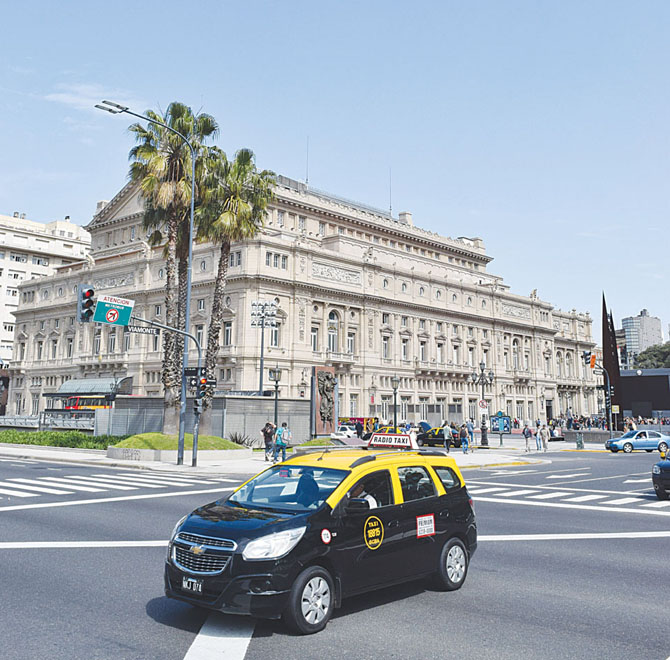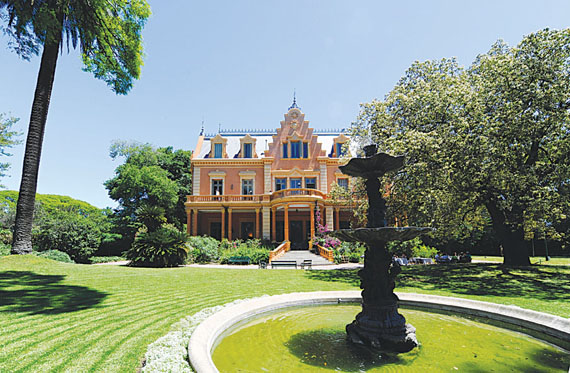On the map Buenos Aires looks like a T-bone steak, with the outer fatty side following the shoreline of the Rio de la Plata. Plata means “silver” in Spanish, and the river — more a small sea actually, and said to be the biggest river in the world, though I bet the Amazon would object — does look kind of silver in certain sunlight. But the name was also derived in Spanish from the vast amounts of precious metal that flowed down it when the conquistadors first exploited the Latin American interior. The English, who have lost the correlation between silver and wealth, just call it the more prosaic River Plate.
***
The obligatory taxi driver story: You get into a Buenos Aires cab and ask in faltering Spanish for the Museo de Arte Latinoamericano de Buenos Aires. “Ah si,” says the Portena driver, using the acronym “Malba” like he drives there every day for his own personal pleasure. This proves to me that Argentines are deeply cultured and artistic people — even down to the average cabbie.

A taxicab in downtown Buenos Aires. (Shutterstock photo)
***
The Argentine economy is fragile. I went to a branch of the bank that handles my business in the UK and the UAE, wanting to take out some folding money to pay for taxis and other things. The most I could withdraw — even from my own checking account — was the equivalent of $105 (just under SR400). This tells me that the authorities are worried about another run on the very vulnerable peso.
***
The Malba museum is actually a wonderful place, and if I were a taxi driver, I’d angle for a fare there as often as I could. Latin America was at the forefront of some of the most innovative movements in art in the 20th century, from Frida Kahlo to (her husband) Diego Rivera and down to Alicia Penalba, whose massive mural sculpture “Flying Forms” will form the backdrop for the G20 wives and partners photo shoot on Saturday. I think Melania Trump will want to buy it. I think Donald will not approve. Not enough gold.
***

Villa Ocampo, a mansion built in 1891 in San Isidro, about 30 km north of Buenos Aires city. (AFP)
Melania might also want to buy the Villa Ocampo, a superb European-style mansion a long way up the Silver River from Malba. It was owned by one of Argentina’s leading ladies of letters, Victoria Ocampo, and is famous for its distinguished list of visitors, including writers Andre Malraux, Albert Camus and Graham Greene, and, bizarrely, Wernher von Braun, the German rocket scientist. Mrs. Trump is there at a reception on Friday, while her husband is off talking trade-war turkey with Xi Jinping. But I think UNESCO, the current owners, would ask for too much — even for a US first lady — if the villa was ever for sale. Which it is not.
***
After all that fine art, sophistication and taxi-driver talk, it was down to the nitty-gritty — getting press credentials for the G20. It is here that you encounter Argentina at its finest: A glorious mid-19th-century building hiding the most hopelessly inadequate registration system known to man. Somewhere around where the bone would have been in that T-bone steak lies the Ministry of External Relations, and it is here the world’s media have to line up for the precious lanyard that gives you access to the International Media Center. After 30 minutes in the dungeons of Esmeralda, I was happy to walk blinking back down the Avenida Santa Fe to freedom, and the Wilton Hotel, to eavesdrop on the football team of BBC journalists planning their assault on the G20. But that recollection can wait for another time.


























